Sands of Salzaar is a sandbox strategy/RPG game that plays something like a cross between Mount & Blade, Heroes of Might & Magic and Diablo. Starts interesting and engrossing, but full of design weaknesses that makes it crumble later on.
Type: Single-player
Genre: Strategy, RPG
Sandbox, Fantasy
Developer: Han-Squirrel Studio
Publisher: X.D. Network Inc.
Release date: 3 Jan, 2020
Introduction
Sands of Salzaar is a RPG and Strategy hybrid set in a fantasized world loosely inspired by islamic mythology.
The game is often described as a cross between Mount & Blade and Diablo, which I feel is both adequate and inadequate in different ways. I’ll also add Heroes of Might & Magic to the list, though I’ll talk more about related games in the next session.
You start by creating your character from a given class, and are promptly thrown into an open world of monsters and warring clans with a single companion. The game progresses quite quickly, however, and you’ll soon have an army of dozens fighting alongside you, ready to conquer the world (although you can also ally yourself with other factions or even become their member, if you so wish).
The sandbox aspect of the game, navigating the politics of clans and characters is probably the selling point of the game.
While the RPG aspect is less developed (with the two main quests having extremely awkward pacing, and the remaining side quests feeling a bit disjointed), the setting was interesting and unique, and I’d certainly like to see it get more development time.
While there are “dungeons”, these are mostly simple “choose your own adventures” mini games with very straightforward choices interspersed with combat instances. Not particularly complex or interesting, but adds some nice variety.
At this stage in Early Access, the game is fully playable, even if it suffers from many design problems (that I don’t think can get fixed, honestly). While it may get better in the future, it is in a decent stage to show what the game is about for anyone interested.
Since the game is already quite large complex, I’ll try to divide the review into short sections, focusing on the more important aspects of the game – most importantly the ones about the combat, the strategy, and the pacing.
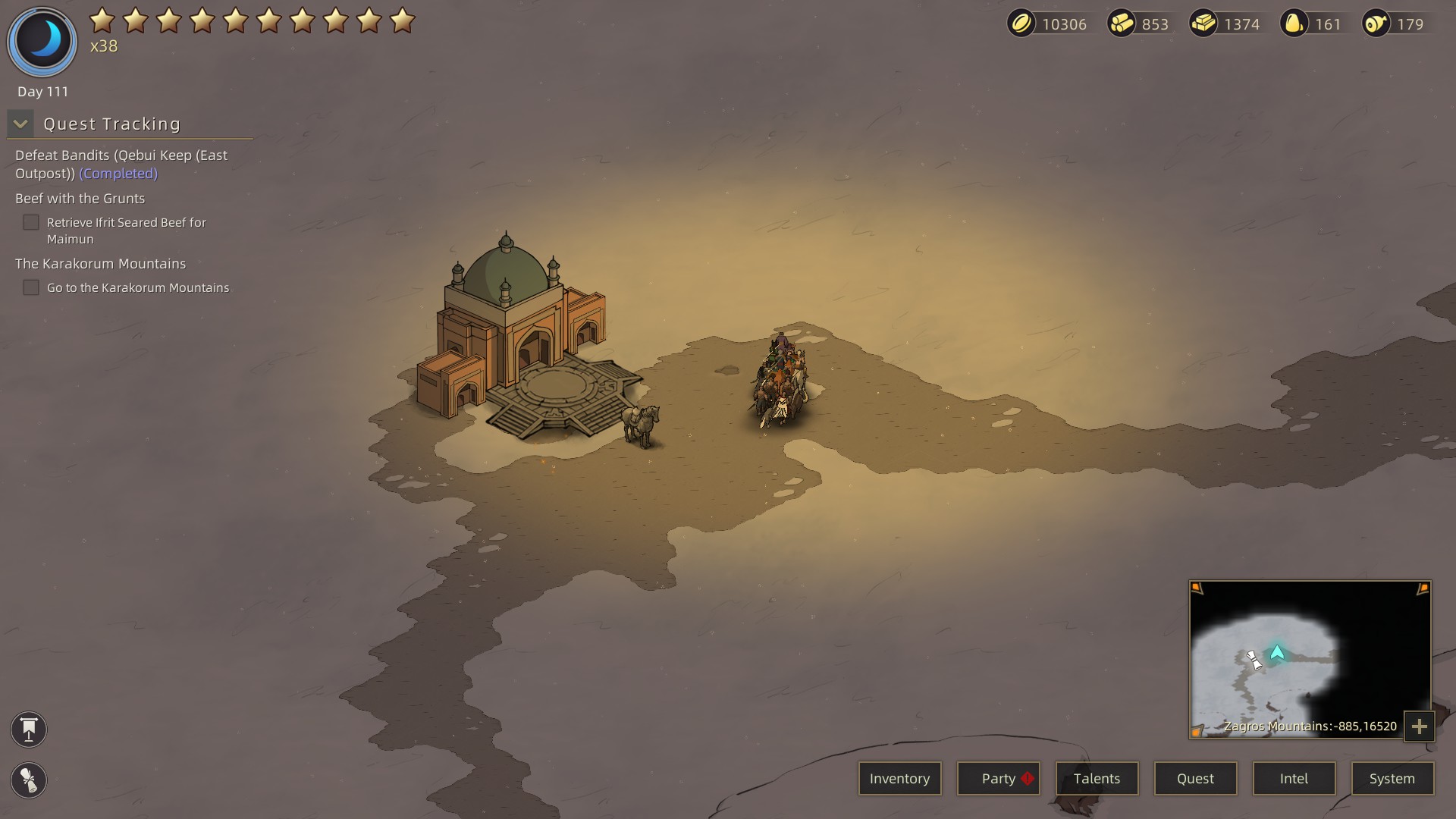
Related Games
This is a strange section to make in a review, but I think Sands of Salzaar deserves a short discussion about related games – especially because it has a very engrossing game loop that while not entirely original, seems to be used in very disparate games.
The first genre to get out of the way is Diablo. While the combat is very similar to it, moving your character by pointing and clicking your mouse, plus a handful of hotkeyed abilities, the actual dynamic is completely different, since 95% of your fights involve at least 5 characters, most of them involves many dozens.
You could probably stay back and simply watch most battles (which makes combat rather boring) and even when you play, it’s not particularly engaging.
All the skilltrees are very simplified, too; there are no synergies, no real “choices”, and you reach max level very early on.
The one thing that is strangely like Diablo, however, is the chance-based drop system. While dungeons are simply generic text adventures (with little to no story and little to no gameplay choices), they are designed to be played repeatedly (with some time interval) for your to find a specific piece of loot.
The second genre, in the strategy department, comes from Mount & Blade. Unfortunately, I have never played Mount & Blade, so I can’t confirm or deny! Two games do fit the bill, however. The first is, unexpectedly, SPAZ2 (Space Pirates and Zombies 2). In both games you have a sandbox world with token cities and factions, which you can appease by completing generic quests for each of them, aiding them in battles against bandits, or offering them gifts (and gold).
You can also attack individual members (or rather, their squad/fleet) as well as try to siege cities and claim them as your own. If you’ve played SPAZ2, I can tell you that the strategy layer is practically identical. Not my cup of tea, but hey.
The third genre is the specific kind of RPG seen in Heroes of Might & Magic and Disciple – or, in my case, Legends of Eisenwald. In fact, this game features both the kind of “overworld” RPG style and the element of faction wars and sieges.
This is probably my favourite aspect of the game. There’s something about traveling through an open “miniature” world with abstracted cities (where cities are reduced to characters and shops) that is just extremely satisfying to me.
Sands of Salzaar unfortunately lacks the brilliant writing and purpose of Eisenwald, and the combat is also much more chaotic.
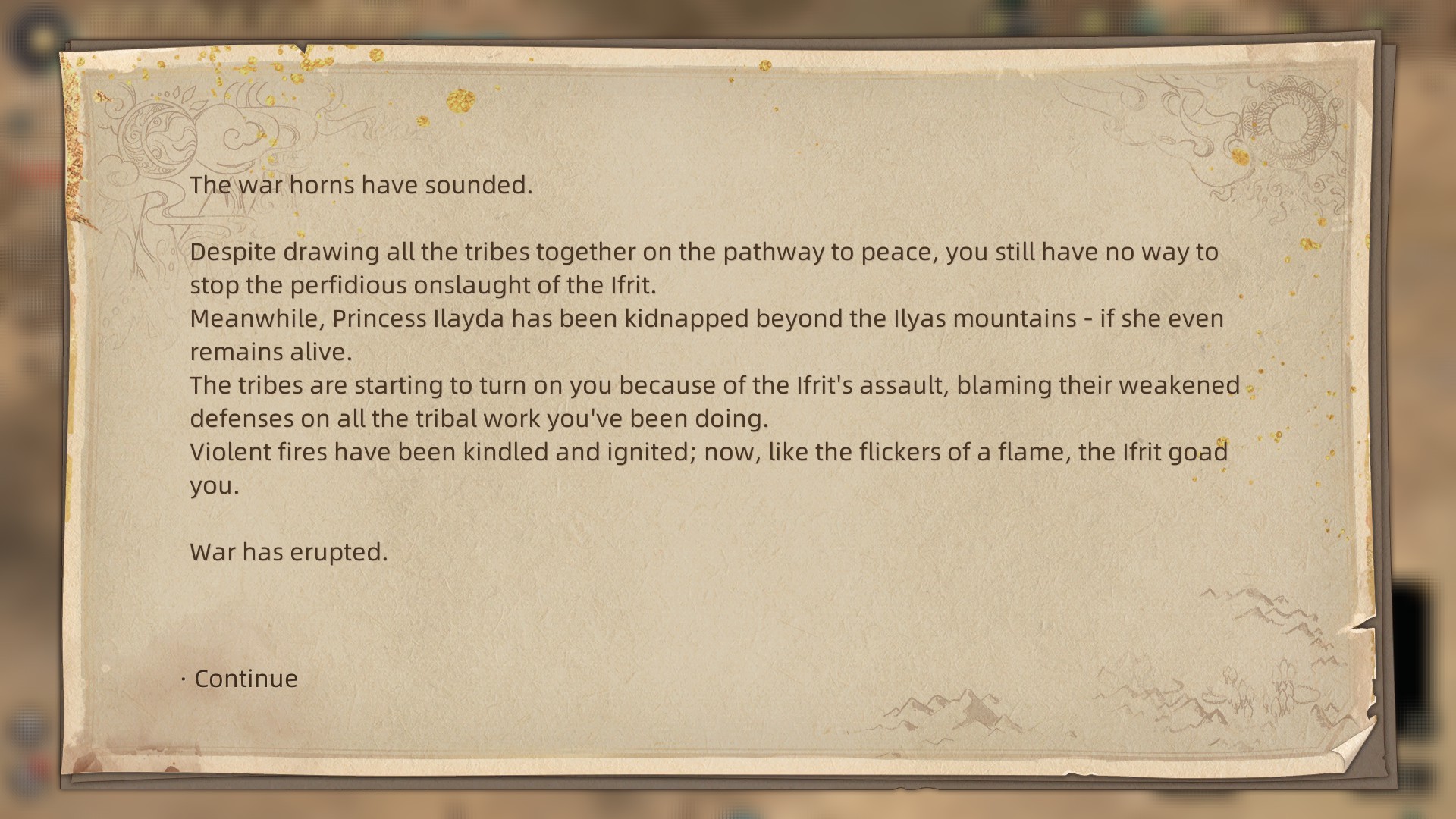
Presentation and Setting
Sands of Salzaar is has an overhead view with hand-drawn graphics that while not stunning, look unique and charming. The biggest problem is the portraits, which are made out of different elements (face shape, beard, eyes, nose, etc.) which don’t always line up properly, resulting in very goofy faces. Nothing too bad, however!
I really love the little buildings and cities. They’re obviously merely symbolic, but each looks unique and seems to portray a genuinely different culture, which is awesome!
The game takes place in Central Asia, which is certainly unique! The music is quite nice, though also a bit of an odd choice. Stylistically, it uses oriental melodies more typical of the Saharan setting than the Gobi/Central Asian one; I guess that’s the style used to evoke the desert. Either way, the music is pretty cool, if a bit repetitive.
The writing is a bit mixed. While I really like some of the themes and language, the quests themselves are rather sparse and … “unfocused”. In Legends of Eisenwald, for example, every quest contributed to the central theme of the game with a different perspective, or added a different flavor of legendry; here, I miss any sense of purpose.
The game is developed by a Chinese company and the translation isn’t fully complete, yet, but the few untranslated lines are mostly in flavor text and are not an obstacle to understanding, for the most part. There are also some typos or awkward phrasing here and there, but the translation is otherwise solid and evocative, so it serves its purpose!
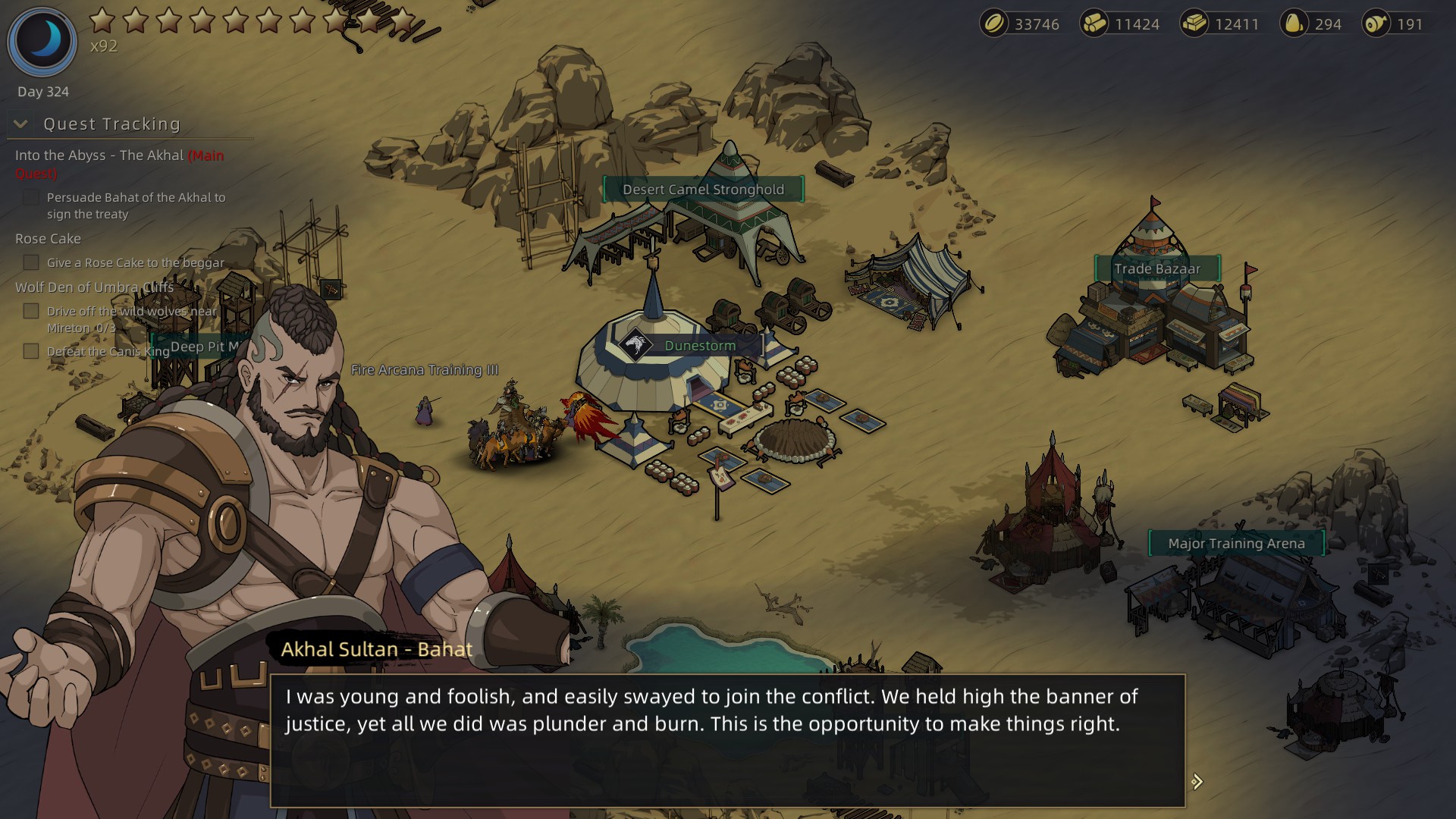
General Gameplay
I’ve already mentioned how the game has a Diablo-styled combat (instanced, not in the world or dungeons), plus a sandbox strategy layer where you deal with clan politics, and finally some simple text-based dungeons. The last one is really underdeveloped, so I’ll skip it and focus on the other two.
The world is completely open from the start (aside from one area reserved for the final phase of the game and some quest-specific dungeons/instances). You will travel around visiting various outposts and cities, where you will find characters to recruit and squads you can buy.
Different places will have different units, which can level up and specialize into different units (Cavalry, Clerics, Mages, Sword and Shield, Dual Wield, etc.). These units aren’t “heroes”, so they have no equipment or skills, but are the bulk of the open battles.
Characters are “heroes”, who behave more or less like the player, with similar skills and the ability to wear equipment and weapons. Characters need to be friended before they will join you. Unfortunately, you can’t control the characters in your party – and they have a much simpler skillset which is static (probably to simplify the AI?). I would have loved to be able to play different characters in a single run.
There are many quests, but most of them are fairly simple. The faction and character quests are generic (go and fight a group of bandits near area A, go deliver this item to city Y, go beat up character Z, etc.), but other quests are “narrative”, in a loose sense.
Most of them still involve going into a certain dungeon or collecting specific plants, mostly fetch quests, but some of the writing is nice (though rarely amazing or deep).
In a way, this is an RPG – you have characters, stats, skill trees, quests, and so on; but the RPG elements are all fairly underdeveloped and simplified (I believe intentionally), and the real meat of the game is the sandbox element, where you have to grind a bit to gain favour with various character and factions as well as level up your squads for them to defend your outposts and cities. Unfortunately, I found the sandbox aspect a bit too abstract and tedious, entirely lacking in interesting choices; but more on that later.
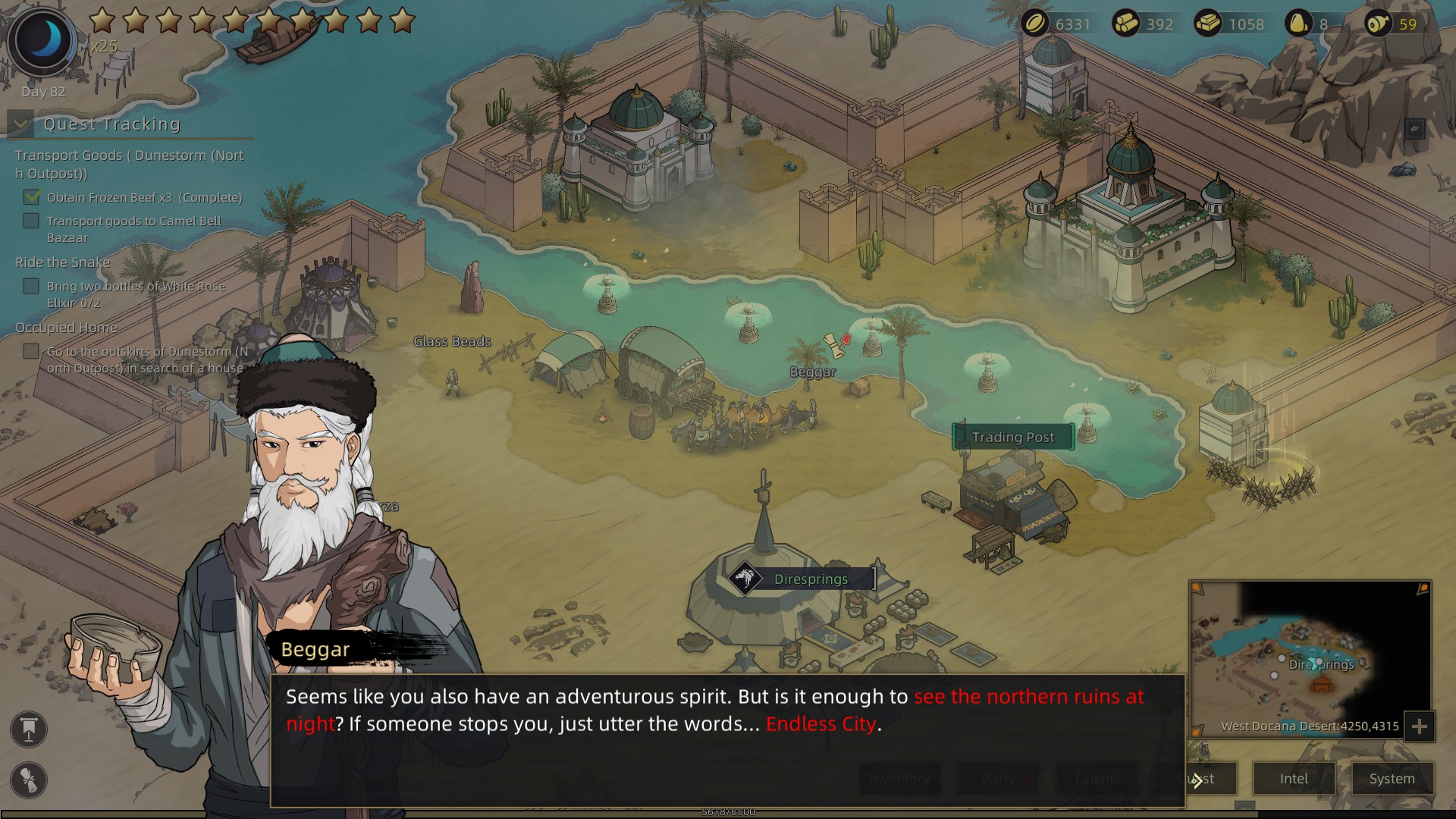
Combat
As I said, the combat is very much like Diablo’s. You point and click, and you use active skills, involving piercing attacks, AOE, summoning creatures, stuns, and so on.
The biggest problem is that the battles are actually between armies, not characters (for 90% of the game). This makes this style of combat entirely inappropriate. Moreover, most skills are tailored for these army battles, making the few instances of single combat extremely awkward and sometimes unfair (as when an opponent is immune to stun but can easily stun lock you into oblivion).
The pieces simply don’t fit together. The skills live between the two worlds of single vs. army combat, but don’t quite fit any. Sure, using big AOE skills in the middle of the enemy army is satisfying, but ultimately negligible when there are 4 other hero characters and hundreds of fodder units.
Meanwhile, single combat is often reduced to kiting the enemy (running away) while you wait for cooldowns to end or mana to recover.
It also gets extremely tedious, later on. In the endgame, especially, everyone was supposed to cooperate against demon cities – except that as soon as we successfully sieged the enemy city, one pissed off character would attack me, thus wasting a few minutes on a huge army battle that served no purpose, only to be repeated on the next siege.
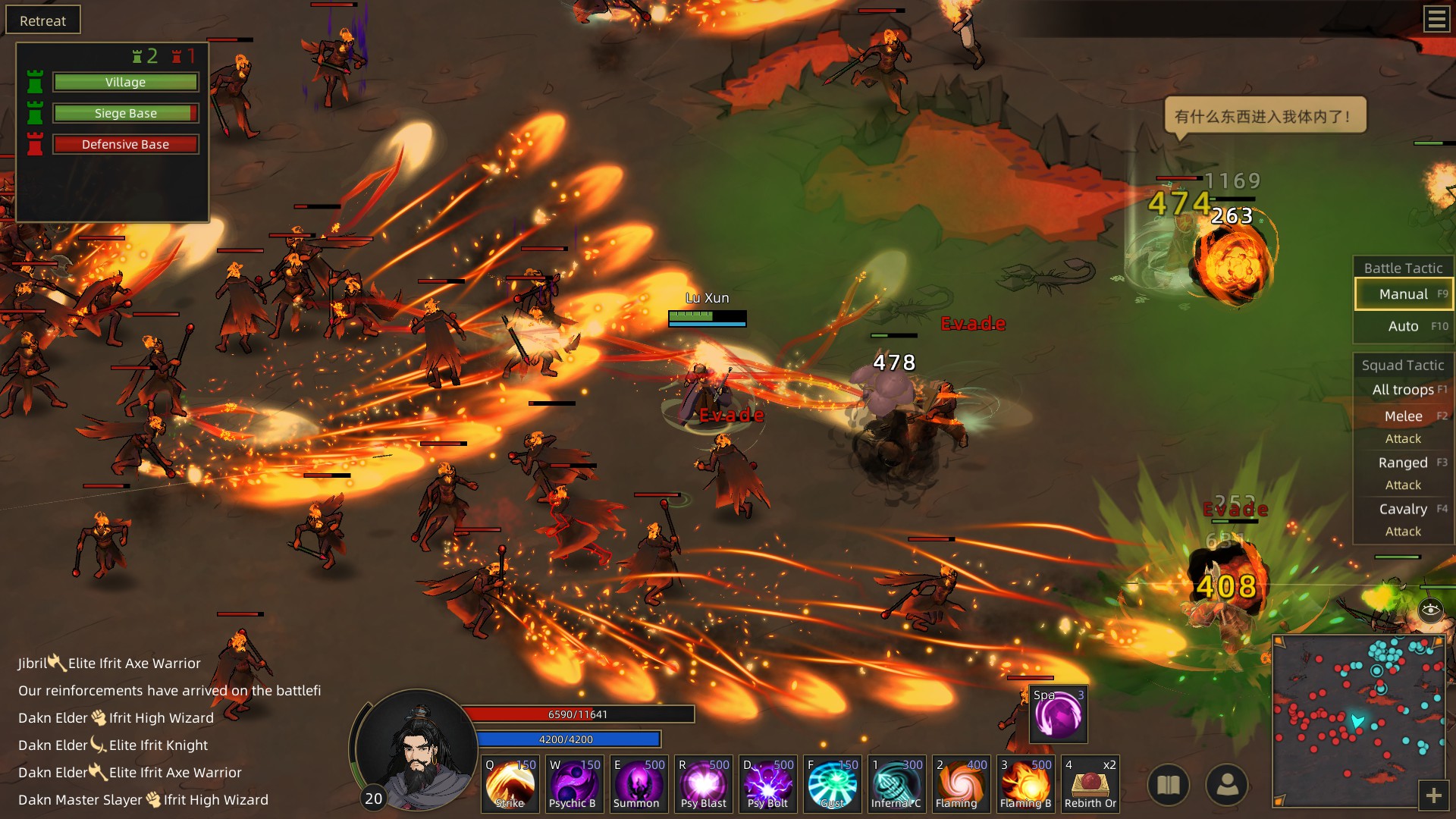
Conquest
The more interesting part of the game, or at least most unique, in its sandbox conquest. The game has 4 or 5 factions, each controlling a different region of the map, but able to navigate between them. Each region has smaller outposts (less defenses and rewards) and larger cities.
You’ll typically find characters in the larger cities.
By conquering a city, you’ll be able to claim it for your own faction, or to free it. Claiming it for yourself will let you upgrade certain buildings to periodically provide you with rewards (gold, iron, wood and jade; used to buy and upgrade troops, especially, or prepare for certain dungeons; gold is also of extreme important for the politics), and also let you buy units specific to the zone.
You will also be able (or required) to station some characters and troops in the cities’ garrison to defend against attacking factions.
Before sieging a city, however, you should take into account that this will piss off the targeted factions, as well as call reinforcements. You’re often better off starting with the smaller outposts to reduce the number of allies in range and build your own supporting force.
I have two big problems with this whole layer of gameplay:
First, it is entirely alienated from most of the rest of the game. Sure, the main story has a section where you must convince all the clans to sign a certain treaty, but this can be done by completing a few character specific quests rather than any diplomatic or martial maneuvering.
Second, it’s tedious. Sure, the first handful of sieges are interesting and new, but sieging your 7th or 12th cities starts to become a chore, since they all play the same. The actual siege involves combat on a slightly larger map with a “hold the point” kind of gameplay, but it’s largely a war of attrition and numbers. In fact, the whole sandbox aspect is a war of attrition. It’s about conquering a city, setting some heroes and high level troops there and there roam around leveling up the next batch of troops and recruiting the next batch of heroes. You repeat this 20 or 30 times. Not very interesting.
It’s also entirely too abstract, which leads to the next section.
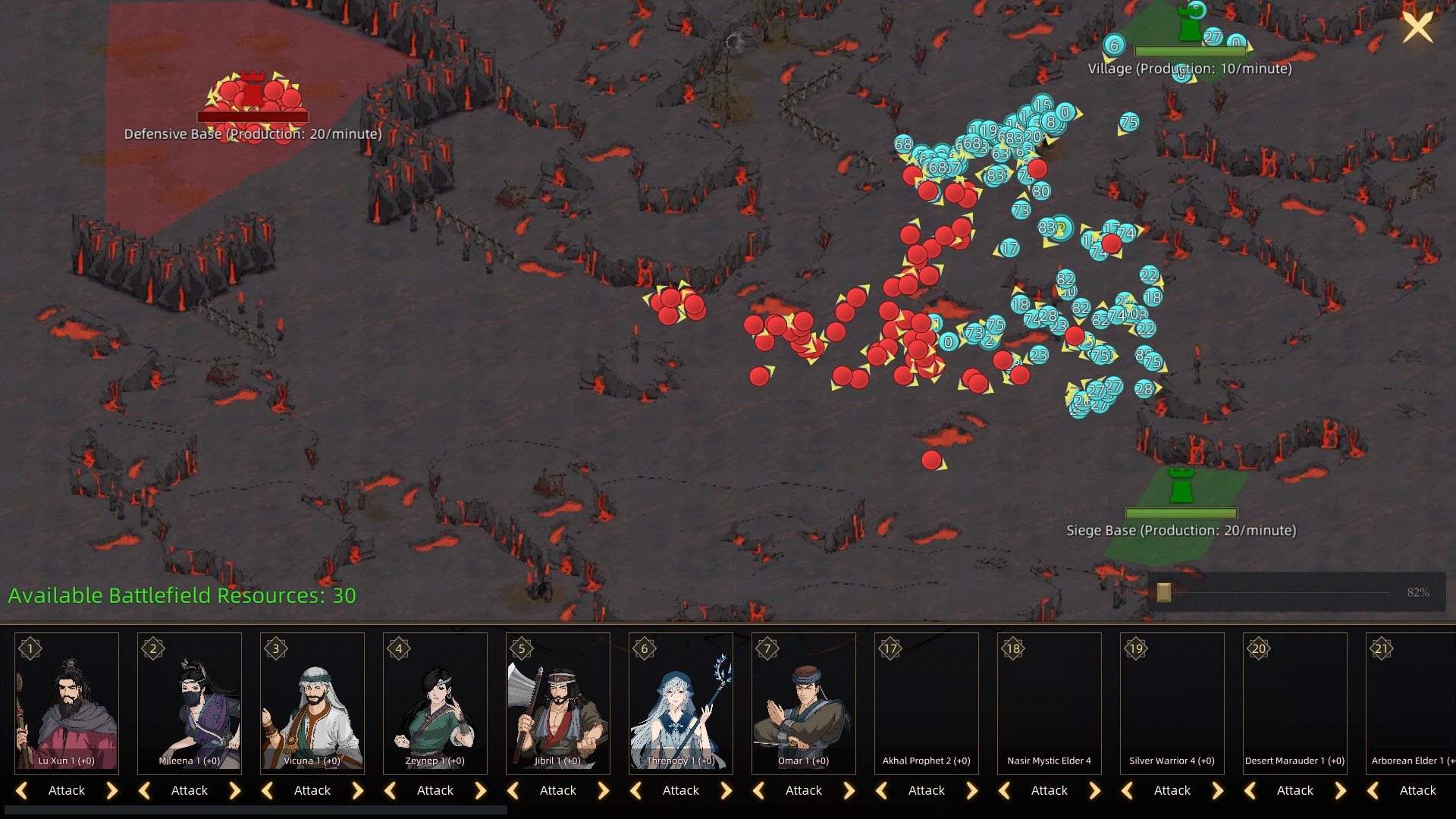
Character and Faction Politics
Like SPAZ2, and unlike Legends of Eisenwald, the factions are entirely lacking in narrative. Sure, they have a backstory and flavor text, but none of it actually means anything for the world or gameplay – it’s the definition of “flavor text”.
It would have been great if factions behaved differently, or had different ways of operating, perhaps different resources (equipment or spells, for example) to exploit, but nah. As far as I know, there are also no faction-related quests (aside from a small detour during the main quest).
Every faction is just like any other, just another point on the map to conquer.
I almost expected a Lords of Midnight-style grandplan of action for each faction, something you had to learn about in order to achieve some end goal by navigating the various interests of the people involved, but nah. What you do is go to each leader to do whatever fetch quests they ask of you, and they’ll sign your treaty.
The same applies to characters. There are many many characters, but they’re all blank. You can easily gain their favour by giving them generic gifts (music, book, combat related objects that you get from dungeons but act only as generic gifts), or completing generic quests (deliver this to that town, beat down some deserter squad, beat some other character, etc.).
Factions are even worse, since the single best way to appease them is to just conquer their cities, gain lots of gold from those cities, and then pay them off.
In the late game, the balance gets completely out of whack, and you’re easily able to conquer every city while maintaining max relation with every faction – as long as you’re willing to put in the time to grind troops.
I don’t know. I like the general idea of it (and have no idea if Mount & Blade does it any better), but it is so abstract and to lose all meaning, to me. It becomes a chore.
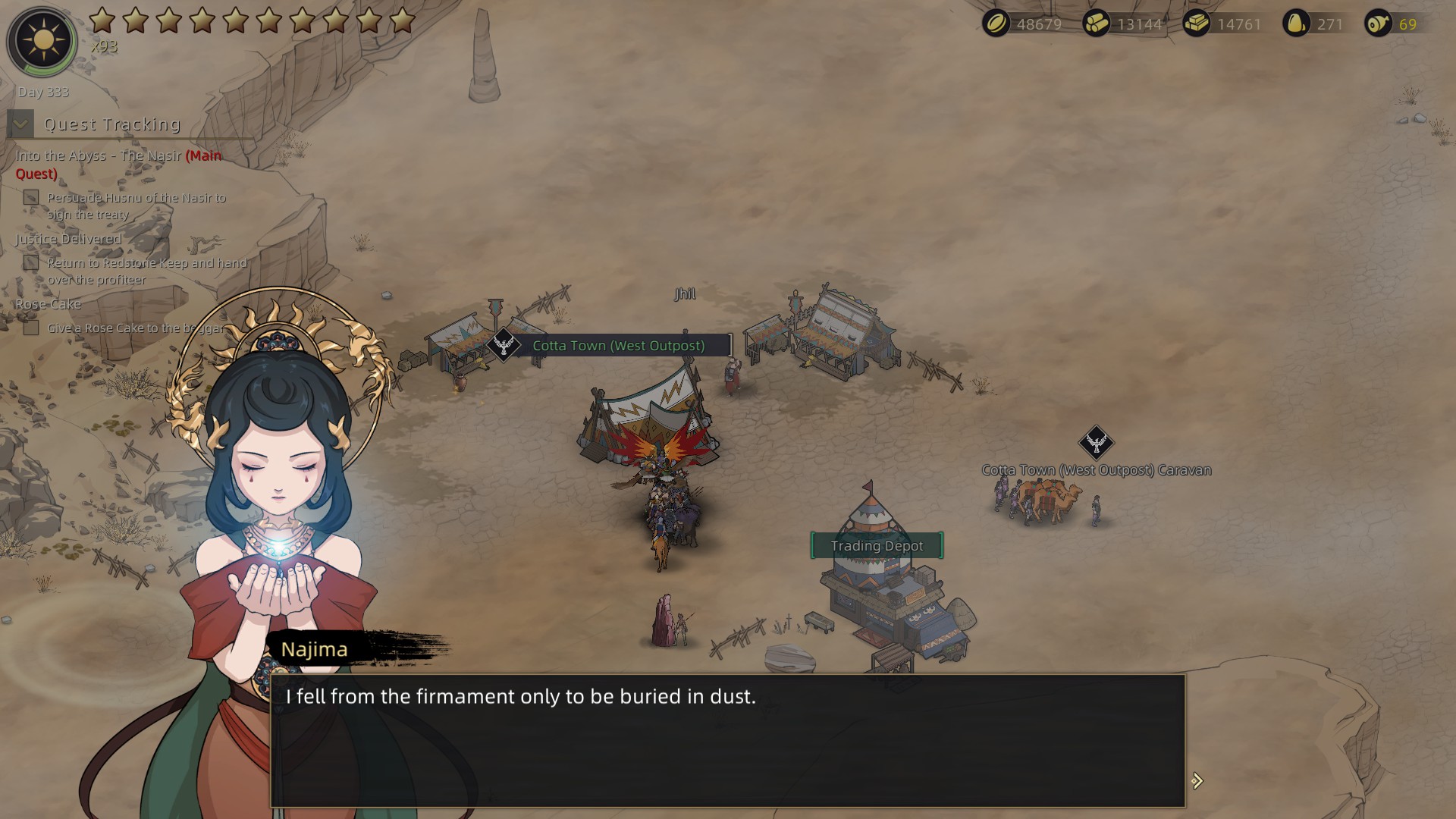
Pacing
Finally, I just want to mention how the quests have extremely weird pacing – perhaps due to the open nature of the world and sandbox gameplay being the focus.
There are 2 main quests – the actual main quest, and the character quest.
The character quest is extremely short and its end came out of nowhere.
The main quest is a bit longer, but it only stalls at the end with quests-within-quests with little purpose. You chase a demon for a while, and then all of a sudden a whole demon world is threatening your world and so you must unify the clans. To do this, you must convince each leader to sign the treaty. Then each leader asks a quest of you involving a character. And that character also has another quest. It has this weird “spoke” structure that is just not very interesting.
Gone are the days of Fallout 1 where one town’s quest actually involved a conflict of interest with another town (where there was actually a role to play in choosing a side or investigating the problem to find an acceptable middle ground!).
The character levels themselves are also extremely weird. I reached max level (20) maybe about 8 hours in, far from the end of the quests. Now, I said the quests were short, right? – yeah, but the world is open, so I spent most of the time roaming around, exploring and doing small side quests.
I wasn’t even grinding at all, just exploring. And reached max level very early, with many many sidequests yet to be done.
It’s just weird, how the character progression caps so early on. It also makes every subsequent quest extremely easy, many with enemies dying in a single hit.
I suppose it is difficult to balance an open world game without level-scaling, but the result here isn’t much more satisfying, either. Perhaps being able to control multiple characters would help, though it’s still a hard sell when the character’s skillset plays such a negligible role in combat.
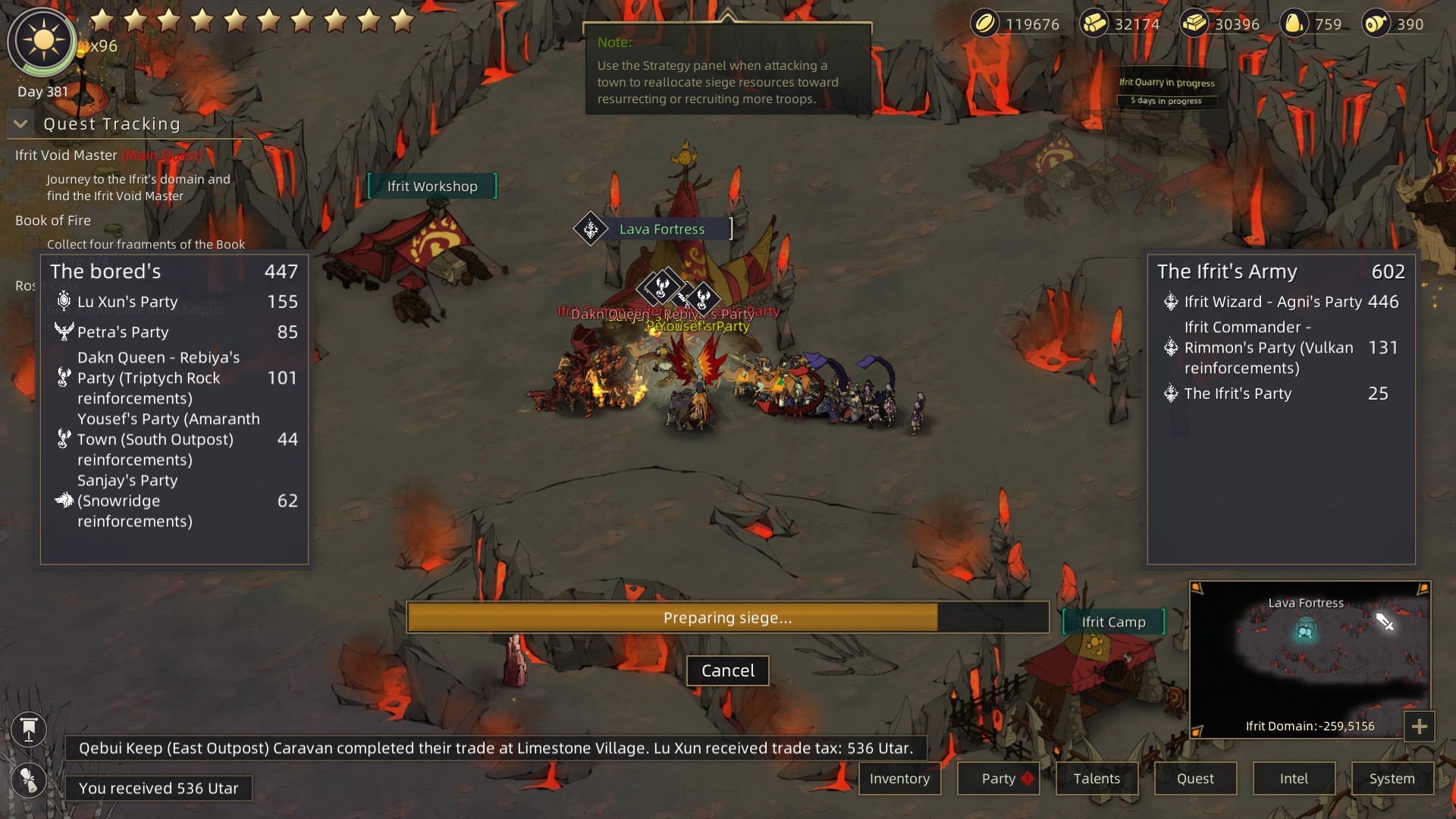
Conclusion
While this seems like a very negative review, don’t misunderstand me – the game is still fun to play! It’s interesting, and has a very compelling loop (again, I love to have such a large free roaming world – at least until the illusion is dispelled, it’s a fun place to live in). But it’s somehow a big and complex game while at the same time seriously lacking in depth in any of its systems. Perhaps it tries to do too much at once and the result is a bit of a tangled mess.
I’m very impressed by how far in development the game is. It’s fully playable and, a few kinks aside, could pass off as a finished game already.
On flip side, it’s full of design and balance problems that make it far from a satisfying finished product – but one I can hardly see being fixed (though this may be lack of imagination on my part).
If the idea of a Heroes of Might & Magic style overworld with Diablo style combat and Mount & Blade sandbox layer sounds appealing to you, by all means, give it a shot! It’s definitely worth trying out, but it probably won’t be the game you really sink your teeth into.










